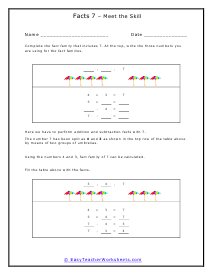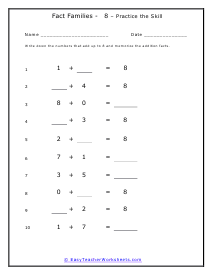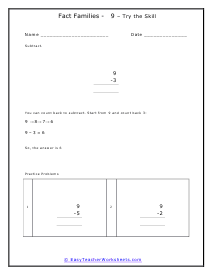On this page you will find a number of lessons that can help students understand how to proceed when working on their math addition facts. We use a series of different prompts and multiple choice worksheets to give students a variety of modes to help them achieve success with this topic. We have a nice system set up for you here. You will first be presented with what could be considered to be a totally independent lesson, where kids can just go off and learn on their own. Then it progresses to baby step them through the skill. This is all followed by plenty of independent learning worksheets. We hope it helps your students master their addition math facts.
Print Addition Math Facts Worksheets
Click the buttons to print each worksheet and associated answer key.

Meet the Skill
Write the addition fact families to match the pictures. Two addition facts and two subtraction facts form a fact family if they use the same three numbers.

Try the Skill
Here we have to perform addition and subtraction facts with 7. As the numbers 3 and 4 are written in some of the blanks. So, the number 7 has been split as 3 and 4. Using the numbers 3 and 4, fact family of 7 can be calculated.

Practice the Skill
Write the values to match the pictures. You will have ten different problems that ask you to generate math addition equations to describe the visuals that you start with.

Addition Facts Practice
We opt to go green with this one. Mix the addition with the subtraction. The families flow together.

Review Worksheet
If one of the numbers of the fact family is given then find which values would complete the addition fact family.

Warm Up
Have a go at these three problems to get yourself in the right mind set with your math facts.

The Odd Man Out
Pick the fact that does NOT belong in the family of 25. You can do this by adding each number of the given pair. Sum in each cell above is 25, so they are called number family of 25. 16 + 7 is not in the number family of 23, as 16 + 7 = 23 and not 25.

Baby Step and Practice
Similar to the above worksheet, we walk you through a math addition facts problem, but we give you two problems of your very own at the end.

Group Practice Worksheet
These problems all follow a multiple choice format, such as: Underline the fact that does NOT belong in the family of 11.

Round #2
More multiple choice problems, ten in all. All will work on identifying facts that fit an equation of somekind.

Multiple Choice Skills
The multiple choice actual make this type of problem much more time consuming.

Addition Facts Starter
We increased the font size and worked on spacing to give you a lot to work around.

Independent Lesson
Directions: Place the given numbers in the correct spot in the number pattern. An example problem: Pick the fact that does NOT belong in the family of 23.




Review Sheet
Sum in each cell above is 23, so they are called number family of 23. You will work on problems such as this.



Skipping Along Sums
An example problem: Write the missing values in which the sum is 6. At the top, write the three numbers you are using for each problem.



Double Line Worksheet
Fill in that final bottom guy for you. This is a great way to put this skill into practical use for yourself.





Facts 7 Independent Worksheet
Write down the numbers that add up to 7 and memorize the addition facts.



Getting Started with 7s
See what values you need to make a complete statement to other numbers around you.


Counting Back 8s Facts
How do you subtract 6? You can count back to subtract. Start from 8 and count back 6:










What are Addition Math Facts?
These are the sight words (if you will) of mathematics. You will sometimes see these referred to as "Fact Families". The basic premise is that two addends always equal a final sum. You can rearrange the integers in many different ways, but you will always end up with the final sum. The goal is to have students understand all of these facts by the time they are ready to enter third grade. One of the best ways to help students focus and grasp this topic is to use flashcards. If you use the menu to your left, you will be able to find addition flashcards as well. Just print them and fold them over and you have a ready to go method to work with students.
Basic addition is something that we all learn and gradually pick up on as we grow older, as it becomes a part of our daily life. From very early on, children learn to add by putting objects together, then using number lines or counting on their fingers. When they have understood the basics, the children move on to learning this skill.
Why is it so important for children to master them? How do you teach them to children?
These are simply the sum of two stated numbers that always give the same result. This is regardless of their order of appearance. For example, 3 + 3 will also equal 6, and 5 + 7 will always equal 12. Memorizing these sums helps speed up math tasks and allows for more complex problems to be solved.
Many schools prefer teaching additional math facts by the 2nd grade. This is because children spend their time till the 2nd grade getting a better understanding of addition and how to add values together. Once they have achieved this understanding, they can move on to complex situations.
Why Are They Important?
Many teachers recommend that the child learn addition math facts up to 20, which is the sum of numbers from 0 + 0 to 10 + 10. This is because they can provide a foundation for the rest of their arithmetic learning. Learning these can help the child in many ways, including:
Learning the Commutative Property: Commutative property states that adding numbers in any order will give the same result. By learning them, students are aided in understanding the commutative property. For example, if the children know that 4+3 equal 7, then they automatically know that 3 + 4 also equals 7.
Adding Two-Digit Number: When adding numbers ten or higher, students start using regrouping addition. Knowing additional math facts makes them understand the "carrying on the one" concept. For example, when they add 7 + 4 and get 11, they know they have one group of 10 and one left over.
Multi-Tasking: Learning this skill allows students to save up some brain juice for complex problems and not waste their time and attention on adding numbers.
Learning Subtraction: When the children know that 4 + 8 equals 12, it will become easier to understand that subtracting 12 - 8 equals 4.
How to Teach Addition Math Facts:
Whether you are a parent or a teacher, it is essential to know how to teach your child addition math facts. These facts will greatly help them when they progress in grades and move on to more complex problems. However, it’s not always easy teaching a child something new. Here are some ways you can help your child learn them:
Explain addition math facts through visual aid. Children learn better when they see it happen rather than hear about it. You can use blocks, pencils, or even cookies. Place the objects in front of them and tell them to count them. Then add a few more and ask them to count them again. Repeat this with a different object. This will build up their understanding.
Use the finger counting method. Some children may be able to add up smaller numbers are 1, 2, and 3, but they face problems with bigger numbers. Tell the students to count using their fingers, with the first finger being one of the numbers. For example, when adding 9+8, tell them to start counting on their ring finger on the dominant hand, beginning the count from 9, and counting until they’ve counted eight fingers.
Use addition math facts games. Create new games that involve addition for children to play, which keeps them attentive towards the task. You could ask them to draw a certain number of things. For example, drawing a tree with four branches, each with 12 leaves.
To Sum Up
Addition math facts are an essential learning objective for children, allowing them to progress to higher levels of problem-solving. Help your child learn better by following the tips mentioned above.
How to Practice Your Addition and Subtraction Math Facts?
It's never too late to learn new things, and that includes practicing your addition and subtraction math facts. In fact, the earlier you start, the better. But it's not too late to catch up, even if you didn't have a good foundation in math when you were younger.
Most people think that to be good at maths, you need to be intelligent. But as it turns out, that's not true at all. Once you get beyond the practice, intelligence and skills are unrelated. So if you're no more competent than the average person, it doesn't mean you can't solve mathematics. Just work on your questions and practice as much as you can.
You can improve your skills by using the following tips.
Understanding is Key
Make sure you understand the concepts. If you're not sure how addition and subtraction work, take some time to review the basics. You can find plenty of resources online or in math textbooks.
Practice Makes You Perfect
Once you have a good understanding of the concepts, practice regularly. You can use addition and subtraction worksheets, flashcards, or online games to help you memorize the facts. It's essential to keep practicing so that you don't forget what you've learned.
Use Mnemonics
For example, you can use the "9-1-1" rule to help you remember that 9+1=10 and 9+2=11. Visualize the addition and subtraction facts as part of a number line. This will help you understand the concepts better and make it easier to do mental math.
Try using a hundred charts, a chart with all numbers from 1 to 100 listed in order. Find the two numbers you want to add or subtract, and then count up or down the appropriate number of spaces to find the answer.
Practice your skills with friends or family members. You can even make it into a game! See who can solve the most problems in a certain amount of time. Keep track of your progress and celebrate your successes. This will help you stay motivated to keep practicing.
Draw Pictures To Represent Problems
Drawing pictures can help you visualize the problem and find a solution. Use manipulatives to model addition and subtraction problems. This can be anything from buttons to Lego blocks. Having a concrete representation of the problem can make it easier to understand.
Write down the addition and subtraction facts that give you trouble. Then, practice them regularly until you have them memorized.
Practice Mental Math
This involves solving problems in your head without using tools or manipulatives. It can be helpful to start with easy problems and work your way up to more difficult ones.
Play Games That Test Your Skills
Games can be a fun and effective way to practice your skills. Try to find games that focus on the specific facts you are having trouble with.
Clear Any of Your Confusion
Don't be afraid to ask for help if you're struggling. Talk to your teacher, tutor, or another math expert if you need extra assistance. You'll be surprised at how quickly your addition and subtraction skills improve with a little practice.
Final Words
These are some great tips to help improve your addition and subtraction skills. Remember to keep practicing regularly, and soon you'll be an expert at math facts!


